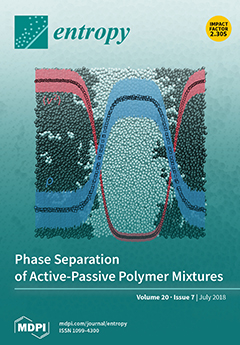The residual multiparticle entropy (RMPE) of a fluid is defined as the difference,
, between the excess entropy per particle (relative to an ideal gas with the same temperature and density),
, and the pair-correlation contribution,
.
[...] Read more.
The residual multiparticle entropy (RMPE) of a fluid is defined as the difference,
, between the excess entropy per particle (relative to an ideal gas with the same temperature and density),
, and the pair-correlation contribution,
. Thus, the RMPE represents the net contribution to
due to spatial correlations involving three, four, or more particles. A heuristic “ordering” criterion identifies the vanishing of the RMPE as an underlying signature of an impending structural or thermodynamic transition of the system from a less ordered to a more spatially organized condition (freezing is a typical example). Regardless of this, the knowledge of the RMPE is important to assess the impact of non-pair multiparticle correlations on the entropy of the fluid. Recently, an accurate and simple proposal for the thermodynamic and structural properties of a hard-sphere fluid in fractional dimension
has been proposed (Santos, A.; López de Haro, M.
Phys. Rev. E 2016,
93, 062126). The aim of this work is to use this approach to evaluate the RMPE as a function of both
d and the packing fraction
. It is observed that, for any given dimensionality
d, the RMPE takes negative values for small densities, reaches a negative minimum
at a packing fraction
, and then rapidly increases, becoming positive beyond a certain packing fraction
. Interestingly, while both
and
monotonically decrease as dimensionality increases, the value of
exhibits a nonmonotonic behavior, reaching an absolute minimum at a fractional dimensionality
. A plot of the scaled RMPE
shows a quasiuniversal behavior in the region
.
Full article






